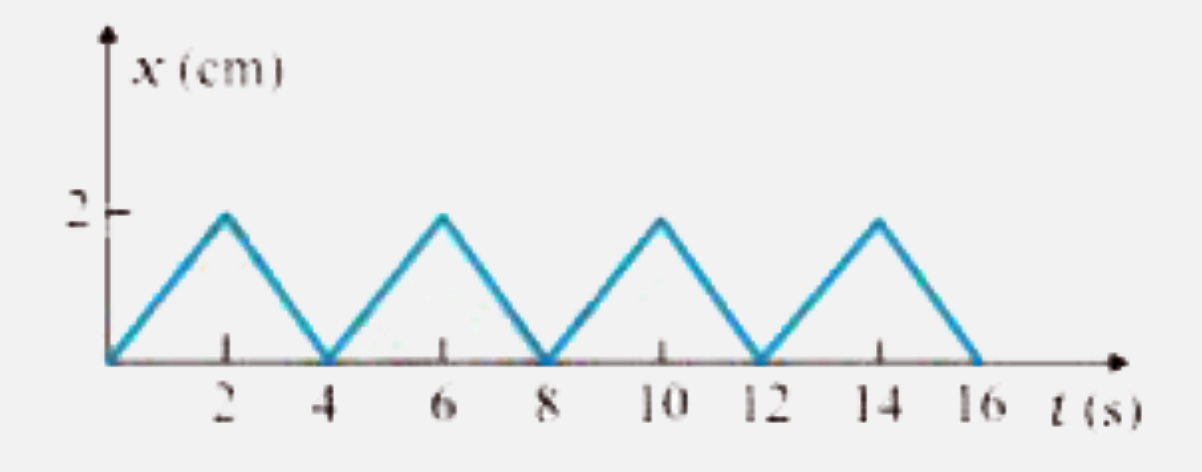The position (x) → time (t) graph of one dimensional motion of a body of mass 0.4 kg. What is the magnitude of impulse of force
 Solution in Gujrati
Solution in Gujrati
1.6 Ns
0.8 Ns
0.4 Ns
0.2 Ns
The correct Answer is:A
(A) 1.6 Ns
Initial velocity of body is V1
=Slope of graph x-t in first two second
=4−02−0=2m/s
Final l velocity of body is v2
slope of x−t graph in last two second
=4−00−4=−2m/s
Impulse of force |Δp|=|m(v2−v1)|
=1.6Ns
Topper's Solved these Questions
- LAW OF MOTIONBOOK - KUMAR PRAKASHANCHAPTER - LAW OF MOTIONEXERCISE - SECTION-F (QUESTIONS FROM MODULE)
22 Videos
- LAW OF MOTIONBOOK - KUMAR PRAKASHANCHAPTER - LAW OF MOTIONEXERCISE - (QUESTION PAPER) SECTION-A
5 Videos
- LAW OF MOTIONBOOK - KUMAR PRAKASHANCHAPTER - LAW OF MOTIONEXERCISE - SECTION-D(NCERT EXEMPLAR SOLUTIONS)
42 Videos
- GRAVITATIONBOOK - KUMAR PRAKASHANCHAPTER - GRAVITATIONEXERCISE - QUESTIONS PAPER Section - D
1 Videos
- MACHANICAL PROPERTIES OF SOLIDS BOOK - KUMAR PRAKASHANCHAPTER - MACHANICAL PROPERTIES OF SOLIDS EXERCISE - QUESTION PAPER
11 Videos
Similar Questions
A block rests on a rough inclined plane making an angle of 30° with the horizontal. The coefficient of static friction between the block and the plane is 0.8. If the frictional force on the block is 10 N, the mass of the block ((in kg) is .......... (Take g = 10 m/s2)
View SolutionWhat is dynamics?
View SolutionA ball is moving with uniform translatory motion. This means that
View SolutionA spaceship is stationed on Mars. How much energy must be expended on the spaceship to launch it out of the solar system ? Mass of the spaceship = 1000 kg, mass of the sun =2×1030kg, mass of mars =6.4×1023kg, radius of mars = 3395 km, radius of the orbit of mars =2.28×108km,G=6.67×10−11Nm2kg2
View SolutionWhat is called brittle material ?
View SolutionThe figure shows the position-time (x-t) graph of one-dimensional motion of a body of mass 0.4kg. The magnitude of each impulse is

View SolutionFigure shows the position-time (x-t) graph of one dimensional motion of a mass 500g. What is the time interval between two consecutive impulses received by the body?

View SolutionThe figure shows the position - time (x - t) graph of one-dimensional motion of a body of mass 0.4 kg. The magnetic of each impulse is

View Solutionचित्र में 0.04 kg सहती के किसी पिंड का स्थिति - समय ग्राफ दर्शाया जय है । इस गति के लिए कोई उचित भौतिक संदर्भ प्रस्तावित कीजिय। पिंड द्वारा प्राप्त दो क्रमिक आवेगों के बिच समय-अंतराल क्या है ? प्रत्येक आवेग का परिमाण क्या है ?

View Solutionचित्र में 0.4 किग्रा द्रव्यमान के एक पिंड की एकविमीय गति का (x−t) ग्राफ प्रदर्शित किया गया है । प्रत्येक आवेग का परिमाण है-

View SolutionThe figure shows the position – time (x – t) graph of one – dimensional motion of a body of mass 0.4 kg. The magnitude of each impulse is:
View SolutionFigure shows the position-time graph of a body of mass 0.04 kg. Suggest a suitable physical context for this motion. What is the time between two consecutive impulses received by the body ? What is the magnitude of each impulse ?

View SolutionFigure shows the position-time graph of a body of mass 0.04 kg. Suggest a suitable physical context for this motion. What is the time between two consecutive impulses received by the body ? What is the magnitude of each impulse ?

View Solution2 किग्रा द्रव्यमान के के पिण्ड का स्थिति-समय ग्राफ चित्र में दिखाए अनुसार है। t = 4 सेकण्ड में पिण्ड पर आवेग क्या होगा?

View SolutionThe position-time graph of a body of mass 0.04 kg. Suggest a suitable physical context for this motion. The time between two consecutive impulses received by the body, the magnitude of each impulse is:

View Solution
